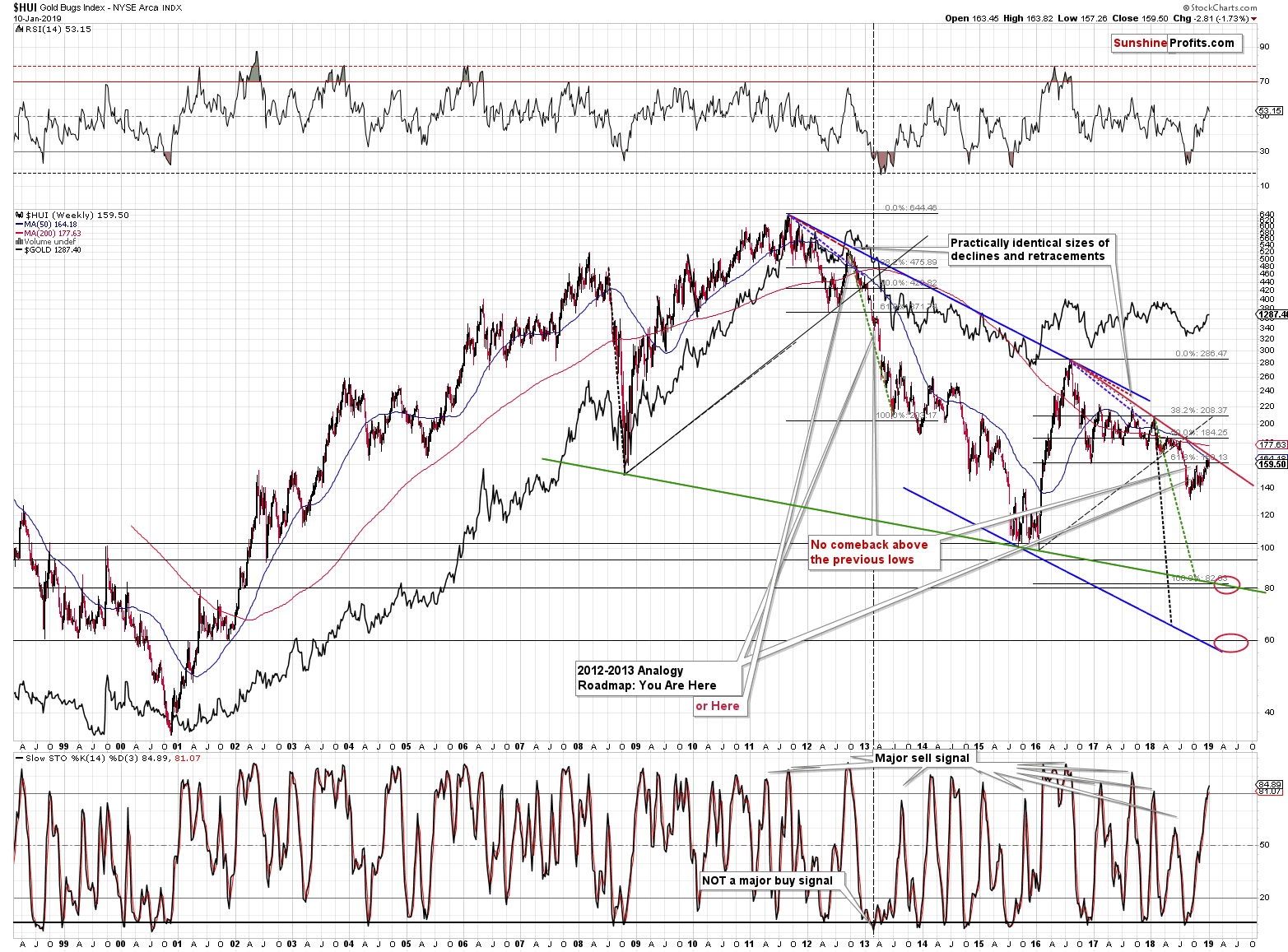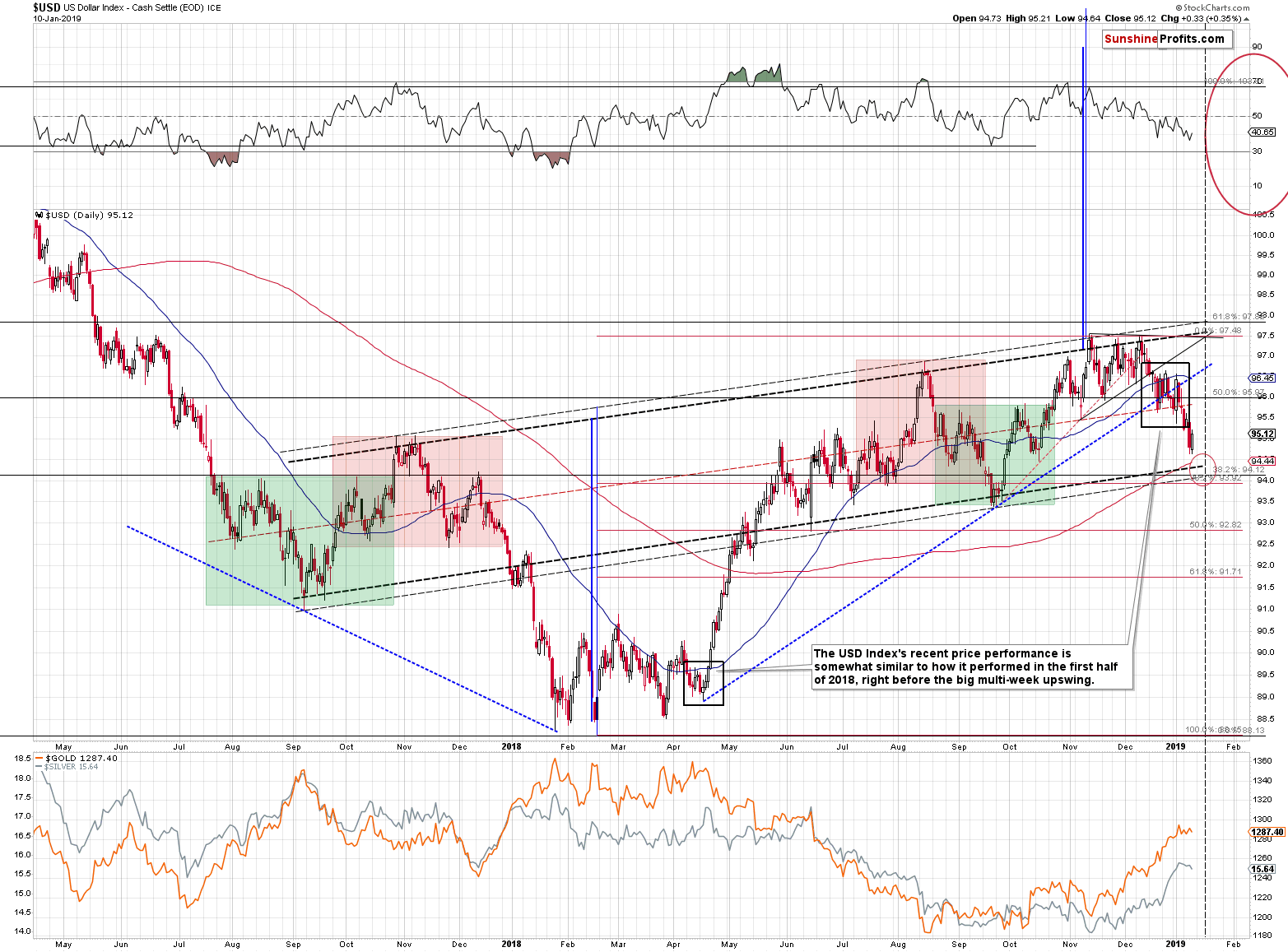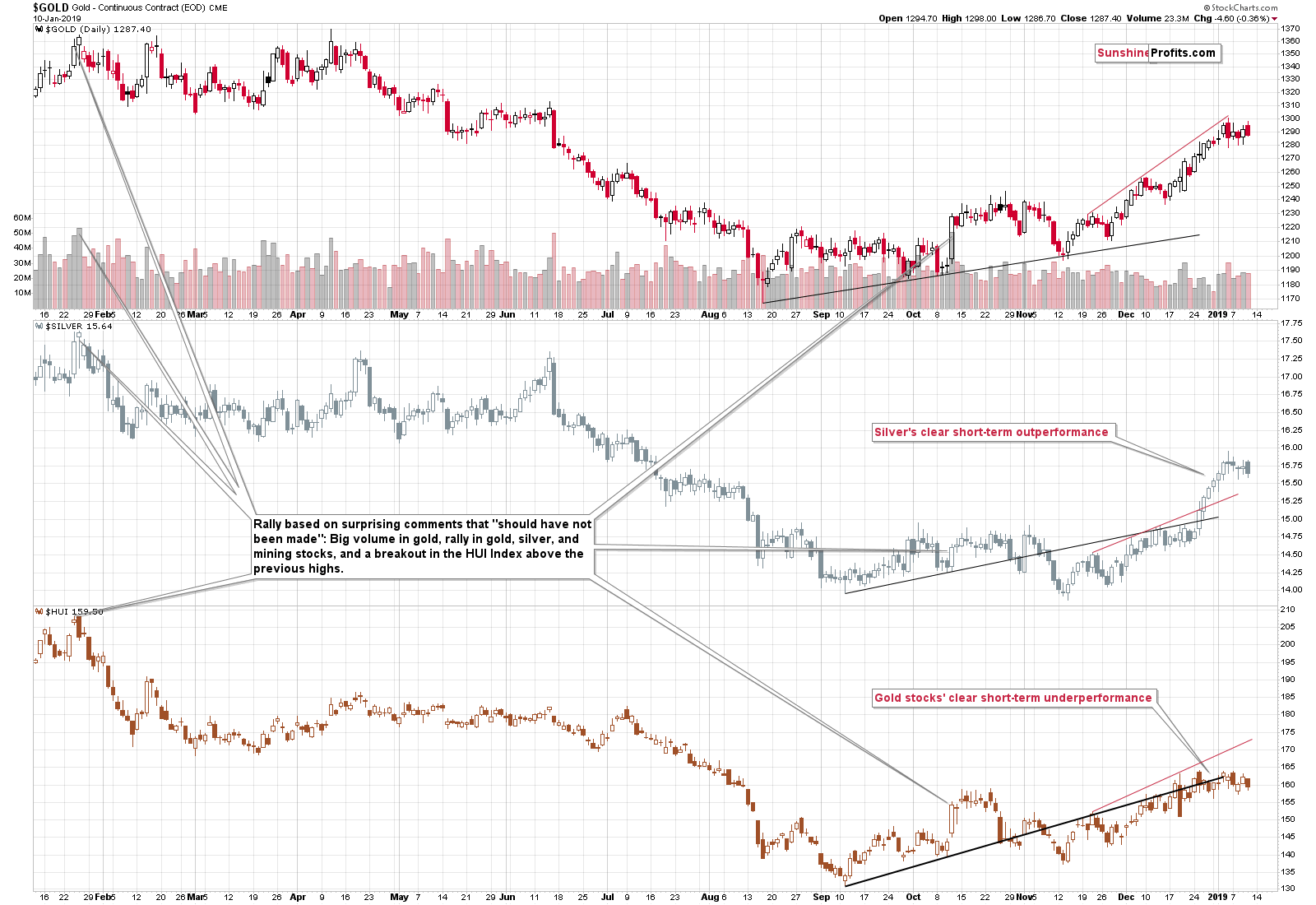Briefly: in our opinion, full (250% of the regular size of the position) speculative short positions in gold, silver and mining stocks are justified from the risk/reward perspective at the moment of publishing this Alert.
The precious metals sector declined yesterday and both: silver and mining stocks closed at new yearly lows. This sounds more spectacular than it really was, because the moves were rather small and in overnight trading, the metals have more or less came back to where they were 24 hours before. Still, something else took place that didn’t get as much publicity as the above-mentioned records. Gold miners moved below their short-term support line. Some may say that this is not a big deal because miners are also right after a breakout above declining resistance line based on the January 2018 and mid-2018 tops. The more long-term signs usually win over the more short-term ones, so the implications of the above should be bullish. But is this really the case?
Not necessarily. The above-mentioned resistance line is not as important as it appears at the first sight, and there are more important issues that one needs to keep in mind. For instance, the relationship between gold and the USD Index. We still may see a small pop up higher in the PMs based on the possible temporary weakness in the USD Index, but this is quite likely to be just a small move up before a big move down. In other words, our yesterday’s comments on the USD Index – gold link remain up-to-date:
The Gold – USDX Link
The USD Index had previously quickly invalidated its breakdown below the rising blue support line, but this wasn’t the case in the last few days. This time, the breakdown below the rising blue support line was just confirmed, which is a bearish sign for the very short term.
We marked the possible downside target for the USD Index, while at the same time keeping the big upside target as well. The rally after the final bottom could be sharp, so both targets could be reached.
The downside target is approximately between 94 and 94.5. That’s about 1 – 1.5 index point decline from the current levels. This approximately means doubling the decline from this year’s top (January 2nd) to the current level. This may seem like a big deal for the precious metals investors, but actually it isn’t one.
The reason is the weakening in the strength of reaction to USD’s bearish signals that we recently discussed by examining gold’s performance in terms of the euro. Gold and silver simply refuse to rally on lower USDX as their respective resistance levels were already reached. On January 2nd, gold closed at $1,284 while silver closed at $15.65. That’s more or less where both metals are right now. Consequently, the repeat of the Jan 2nd – today performance wouldn’t mean practically anything for the PMs.
In other words, while the USD Index may decline in the next several days, the precious metals sector is not likely to rally in a meaningful way based on it. However, if the USD Index moves higher (and the yen declines in value), gold and silver will likely plunge. The above (just the above, without taking other factors into account) appears to have only mildly bearish implications for gold and silver, but at the same time it’s definitely justified to keep the short positions intact. This may seem surprising, but it is really the case.
While probability of small upswing and big declines in the next few days may be similar for the PMs (thus implications may appear neutral or close to neutral), the likely size of the moves are not. The upside potential for the PMs appears very limited, while the downside potential is huge. Moreover, adding more factors to this picture – the ones that we described previously – makes the current short position definitely justified from the risk to reward point of view.
The above remains up-to-date. The USDX moved to 94.64 yesterday, which is close to the target area that we mentioned yesterday (94 – 94.5), but not yet in it. Consequently, we may see a bit more weakness in the following hours and – perhaps – days. The key thing is that the lower border of the target area will be reached if yesterday’s decline is simply doubled (approximately).
Let’s see how the PMs fared yesterday.
Precious Metals’ Small Rally
In yesterday’s Alert, we wrote the following to emphasize the importance of the current link between the USD Index and gold:
Gold was up by just $6 and none of the intraday highs (in gold, silver, and mining stocks) exceeded the previous intraday highs. We can say the same thing about the closing prices. This confirms our previous comments – the PMs and miners are not willing to react to USD’s weakness.
If the strength of the reaction stays at the same level and the USDX declines by as much as it declined yesterday, then it’s natural to expect PMs to approximately repeat their yesterday’s performance as well. Another $6 upswing in gold is a very small move and not something that would justify making changes to the current position, especially that the USD Index might bottom and rally from the middle or upper part of the target area, it doesn’t have to necessarily decline to the lowest part thereof.
The above remains intact. Silver and miners did close at new yearly lows, even though there was no new intraday low. It seems bearish, but its rather neutral, because at the moment of writing these words gold is exactly where it was 24 hours ago, and silver is a bit below where it was 24 hours ago. However, there was a technical sign in case of the mining stocks that we would like to say more about.
Gold Stocks’ First Breakdown
Gold stocks broke below the rising green support line that’s based on the most recent lows. The line is based on 3 lows (last one in late December), which means that it already worked once. It was also where miners closed on Tuesday after the intraday reversal. This line was finally broken yesterday. The breakdown is not yet confirmed, so it’s not yet a very bearish sign, but it seems to be a good sign that the very short-term dynamic has changed. We have ton of medium-, and long-term signs pointing to much lower PM prices, so a very short-term sign suggesting that the waiting may be over is a good addition.
Still, since gold and silver moved higher in today’s overnight trading, it wouldn’t be surprising to see miners move to this green line (to about 162.5) and verify the breakdown.
We recently received a question about the declining resistance line that’s based on the January 2018 and July 2018 tops. Namely, why we are not describing the breakout above it. The reason is that it’s a line that’s similar to a much stronger (based on more important highs) line that’s very close to it. We’ll show it on the very long-term HUI Index chart. We saw a breakout above this line, but the day we saw it, was also the day when the late-2016 low was reached, which is also a more important resistance than the resistance based on the two 2018 highs. Consequently, when there were bullish implications of the less important line being breached, we had two bearish implications of the more important lines not being breached.
Before moving to the broader HUI picture, please note how the HUI Index topped right at the vertex of the triangle based on the above-mentioned red resistance line and the rising green support line, thus further confirming the usefulness of this technique.

The 2016 top and the 2018 top is a much more important combination than two 2018 tops. One of them is the same (the early 2018 top), so the difference comes from the relative importance of the 2016 top and the mid-2018 top. The former is clearly visible on the above chart, while we bet that you had to focus for a while to even notice the mid-2018 top on the above chart.
More important tops create more important resistance and support lines. The red line that’s based on the 2016 and 2018 tops was definitely not broken and the same goes for the late-2016 bottom (in terms of the daily closing prices) – the outlook remains bearish.
Summary
Summing up, this prolonged correction within the big downtrend has been very tiring, but based on the long-term factors being patient was very well worth it, and based on the short-term signs it seems that the waiting is over or about to be over. The outlook for the precious metals market remains very bearish for the following weeks and months and short position remains justified from the risk to reward point of view, even if we see a few extra days of back and forth trading or even a small brief upswing. There is a very high probability of a huge downswing that makes the short position justified, not the outlook for the next few days. It's confirmed by multiple factors, i.a. silver’s extreme outperformance and miners’ underperformance, gold’s performance link with the general stock market, gold getting Cramerized, and the bullish medium-term outlook for the USD Index and bearish outlook for the key part thereof – the Japanese yen. Even if the USD Index moves lower in the next several days, it shouldn’t have a major impact on the prices of PMs.
As always, we’ll keep you – our subscribers – informed.
To summarize:
Trading capital (supplementary part of the portfolio; our opinion): Full short positions (250% of the full position) in gold, silver and mining stocks are justified from the risk/reward perspective with the following stop-loss orders and exit profit-take price levels:
- Gold: profit-take exit price: $1,062; stop-loss: $1,313; initial target price for the DGLD ETN: $82.96; stop-loss for the DGLD ETN $44.97
- Silver: profit-take exit price: $12.32; stop-loss: $16.04; initial target price for the DSLV ETN: $47.67; stop-loss for the DSLV ETN $24.68
- Mining stocks (price levels for the GDX ETF): profit-take exit price: $13.12; stop-loss: $22.03; initial target price for the DUST ETF: $80.97; stop-loss for the DUST ETF $20.37
Note: the above is a specific preparation for a possible sudden price drop, it does not reflect the most likely outcome. You will find a more detailed explanation in our August 1st Alert. In case one wants to bet on junior mining stocks’ prices (we do not suggest doing so – we think senior mining stocks are more predictable in the case of short-term trades – if one wants to do it anyway, we provide the details), here are the stop-loss details and target prices:
- GDXJ ETF: profit-take exit price: $17.52; stop-loss: $32.03
- JDST ETF: initial target price: $154.97 stop-loss: $42.17
Long-term capital (core part of the portfolio; our opinion): No positions (in other words: cash)
Insurance capital (core part of the portfolio; our opinion): Full position
Important Details for New Subscribers
Whether you already subscribed or not, we encourage you to find out how to make the most of our alerts and read our replies to the most common alert-and-gold-trading-related-questions.
Please note that the in the trading section we describe the situation for the day that the alert is posted. In other words, it we are writing about a speculative position, it means that it is up-to-date on the day it was posted. We are also featuring the initial target prices, so that you can decide whether keeping a position on a given day is something that is in tune with your approach (some moves are too small for medium-term traders and some might appear too big for day-traders).
Plus, you might want to read why our stop-loss orders are usually relatively far from the current price.
Please note that a full position doesn’t mean using all of the capital for a given trade. You will find details on our thoughts on gold portfolio structuring in the Key Insights section on our website.
As a reminder – “initial target price” means exactly that – an “initial” one, it’s not a price level at which we suggest closing positions. If this becomes the case (like it did in the previous trade) we will refer to these levels as levels of exit orders (exactly as we’ve done previously). Stop-loss levels, however, are naturally not “initial”, but something that, in our opinion, might be entered as an order.
Since it is impossible to synchronize target prices and stop-loss levels for all the ETFs and ETNs with the main markets that we provide these levels for (gold, silver and mining stocks – the GDX ETF), the stop-loss levels and target prices for other ETNs and ETF (among other: UGLD, DGLD, USLV, DSLV, NUGT, DUST, JNUG, JDST) are provided as supplementary, and not as “final”. This means that if a stop-loss or a target level is reached for any of the “additional instruments” (DGLD for instance), but not for the “main instrument” (gold in this case), we will view positions in both gold and DGLD as still open and the stop-loss for DGLD would have to be moved lower. On the other hand, if gold moves to a stop-loss level but DGLD doesn’t, then we will view both positions (in gold and DGLD) as closed. In other words, since it’s not possible to be 100% certain that each related instrument moves to a given level when the underlying instrument does, we can’t provide levels that would be binding. The levels that we do provide are our best estimate of the levels that will correspond to the levels in the underlying assets, but it will be the underlying assets that one will need to focus on regarding the signs pointing to closing a given position or keeping it open. We might adjust the levels in the “additional instruments” without adjusting the levels in the “main instruments”, which will simply mean that we have improved our estimation of these levels, not that we changed our outlook on the markets. We are already working on a tool that would update these levels on a daily basis for the most popular ETFs, ETNs and individual mining stocks.
Our preferred ways to invest in and to trade gold along with the reasoning can be found in the how to buy gold section. Additionally, our preferred ETFs and ETNs can be found in our Gold & Silver ETF Ranking.
As a reminder, Gold & Silver Trading Alerts are posted before or on each trading day (we usually post them before the opening bell, but we don't promise doing that each day). If there's anything urgent, we will send you an additional small alert before posting the main one.
=====
Latest Free Trading Alerts:
Was 2018 good or bad for the previous metals market? We invite you to read our today’s article and learn more about the most important drivers of the gold prices in 2018. This analysis should help investors better understand the gold market, and draw investment conclusions for the new year.
=====
Thank you.
Sincerely,
Przemyslaw Radomski, CFA
Editor-in-chief, Gold & Silver Fund Manager






